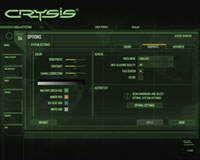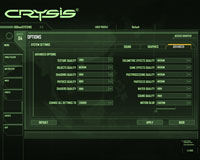Crysis
Publisher: Electronic ArtsWe also tested Crysis using DirectX 9.0 with patch 1.2 applied. We used the same timedemo recorded on the Harbor map which is more representative of gameplay than the built-in benchmark that renders things much faster than you're going to experience in game. We found that around 30-33 fps in our timedemo was sufficient enough to obtain a playable frame rate through the game. It's a little different to other games in that the low frame rates still appear to be quite smooth.
For our testing, we set Texture Detail, Shadows Quality, Physics Quality, Shaders Quality and Water Quality to High, while all other settings were set to medium. Because of how intense the game is, we tested with both anti-aliasing and anisotropic filtering disabled at resolutions above 1680x1050 for the time being. There is currently no support for anisotropic filtering in the game, but you can still force it from the driver control panel.
DirectX 9.0
Crysis's DirectX 9.0 mode is less memory bandwidth intensive than its DirectX 10 mode, and the GeForce 9800 GTX extends its lead over both the GeForce 8800 GTX and GeForce 8800 GTS 512MB graphics cards. At the same time, it delivers a similar overall experience to the Radeon HD 3870 X2, which costs quite a bit more.
Despite the game being less memory bandwidth intensive, it's not completely free of bandwidth limitations because the 9800 GTX's advantage over its successor really shows up when anti-aliasing is disabled. When AA is applied, the performance difference is reduced, but the former still has an advantage over the latter.

MSI MPG Velox 100R Chassis Review
October 14 2021 | 15:04











Want to comment? Please log in.